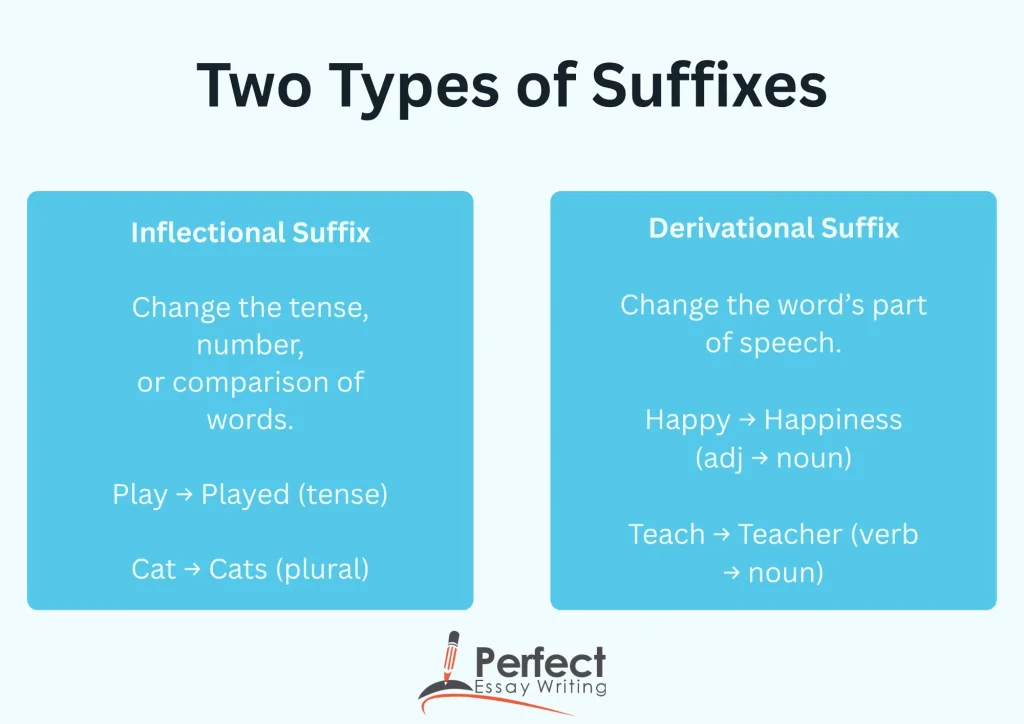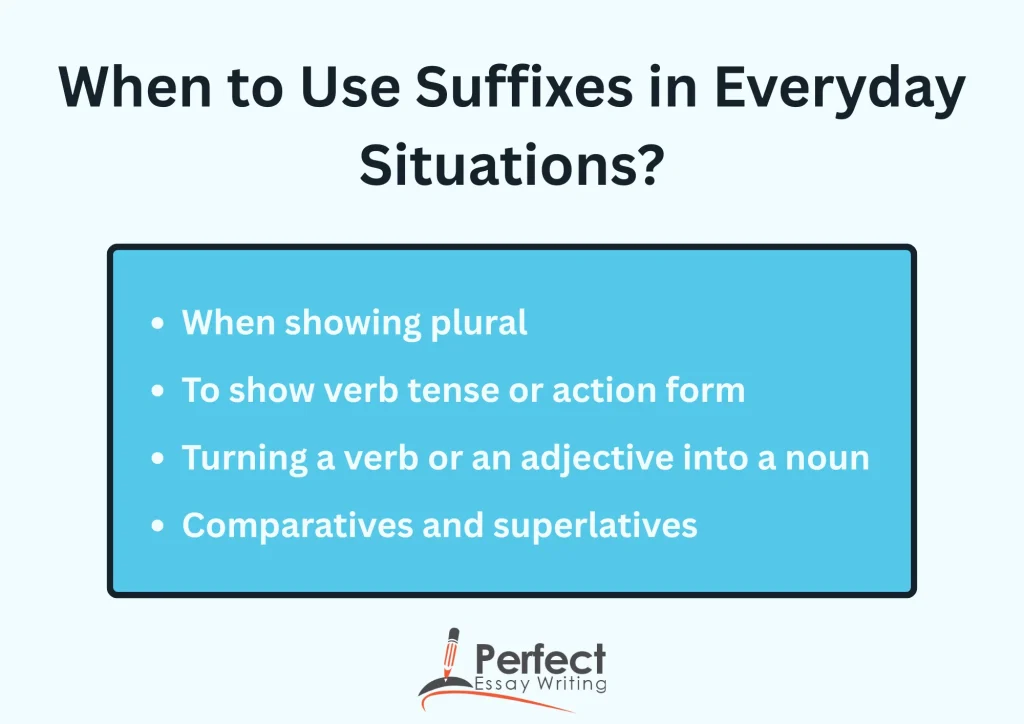Share this link via
Or copy link

Have you seen the word “kind” and are surprised by how it could be converted to “kindness”? That’s what is a suffix can do. It is the essential building block in English grammar. The suffixes in English are additional letters that we add at the end of the base word to change its meaning or grammatical function.
Whether you are a student, teacher, writer, or someone who loves improving vocabulary, learning the suffix is essential. Therefore, we craft this guide, highlighting suffix types, examples, everyday situations to use, and mistakes to avoid so you can read better, write smarter, and communicate clearly.
A suffix meaning in English, is a letter or group of letters added to a word’s end to form a new word. It changes a word’s meaning, tense, or part of speech (like turning a verb into a noun). You can think of it this way: A suffix acts like a tail you add to a word to give it a new job.
For example, “Happy” is an adjective, and when you add -ness at the end, it converts to “happiness”, which is a noun. By this example of a suffix, it’s clear that a suffix helps build thousands of words in English. Learning them enables you to guess the meaning of new words and to avoid common grammatical mistakes at all costs.
Inflectional and derivational are two types of suffixes in English, where inflectional suffixes are used for grammatical purposes while derivational suffixes are used to change word types. However, below are the differences between inflectional suffixes vs derivational suffixes in detail.

This type of suffix changes the word’s grammatical form, but does not alter the meaning of the word. In other words, inflectional suffixes express tense, plurality, possession, and comparison. For a better understanding, let’s say we add the -S to the word “book” to make the word “books” to show there is more than one book.
Similarly, adding an -ed at the end of the word “Walk” changes it to walked (shows the past tense). In both cases, we see that Inflectional suffixes words are predictable and follow grammar rules. They didn’t create new words; instead, they helped us use existing words correctly in sentences.
This type of suffixes in English adds letters to the end and creates a new kind of word with a different meaning. In fact, it changes the entire dimension of the sentence, such as a derivational suffix changes a verb into a noun, an adjective into an adverb, or adds a new shade of meaning. When learned appropriately, this suffix type enables you to identify the word’s part of speech even at first glance.
In everyday writing and reading, using suffixes words helps you understand the form of a word, its meaning, and its function in English. Here are four common situations where suffixes are used widely.

Adding suffixes such as -s or -es when we need to make a noun plural. This suffix in a sentence helps to express the quantity of things.
Tip: We must learn that some words are not meant to be pluralized by adding s or es, such as the plural for man is men, not “mans”. So be aware of the words before adding a suffix.
Using the words with suffixes -ed, -ing, -s to indicate that some action happens either in the present, past, or ongoing. Here, the suffixes are responsible for building correct sentences and the timeframe.
Tip: In some words, we have to double the letter that appears right before where you add the suffix letters. As you can see above, where “run” is with one “n”, but when adding a suffix, it becomes running with double “n”.
Suffixes such as -tion, -ment, -ness, -ity, -er, -or are used when converting verbs or adjectives into nouns, so actions and qualities could be turned into things or concepts. Here are the suffix examples in English.
Tip: This is an effective way to expand your vocabulary, especially when writing formal or academic papers.
Comparatives and Superlatives suffix are common when comparing two or more things in your writing. You must use suffixes such as -er and -est.
Tip: Use -er for comparing two, and -est for among three or more things.
Suffix words list with their appropriate meanings will help you with reading, writing, and vocabulary. Therefore, we have compiled the following suffix examples in English.
| Suffix | Meaning | Examples |
| Noun Suffixes | ||
| -ness | State or quality | Madness |
| -ment | Action or process | Development |
| -tion | Condition or result | action |
| -er | A person who does | Teacher |
| -ity | State of being | Activity |
| Adjective Suffixes | ||
| -ful | Full of | Helpful |
| -less | Without | careless |
| -ous | Full of | Nervous |
| -able | Capable of being | Readable |
| -ive | Having the nature of | Creative |
| Verb Suffixes | ||
| -ize | To make or become | Modernize |
| -en | To cause to be | Strengthen |
| -ate | To act or cause | Activate |
| Adverb Suffix | ||
| -ly | How something is done | Quickly, Happily, Luckily |
Prefixes and suffixes words change the meaning of words by adding a group of letters to them. However, the place where those letters are placed makes the difference.
| Features | Prefix | Suffix |
| Position | Beginning | End |
| Function | Changes the meaning of the word | Change in meaning or part of speech |
| Example | Adding -un before happy makes it Unhappy | Adding -ness at the end of kind makes it kindness |
Understanding what is a suffix makes your grammar part in academic writing impactful. It is essential for essays and assignment tasks. But with short deadlines, how could a student take a keen eye on every suffix used accurately? No worries about this, because our assignment writing services are at your assistance. We have decades of experience writing assignments and fixing suffixes in English students’ essays and assignments. So, contact us today and see how our expertly written assignments make a difference.






We are a team of professional writers providing quality-assured essays, research papers, and assignments. We bring the most affordable services for you with multiple revisions. Get plagiarism-free content with Turnitin pass and on-time delivery. We Create Great Content, Value, & Reliability!



